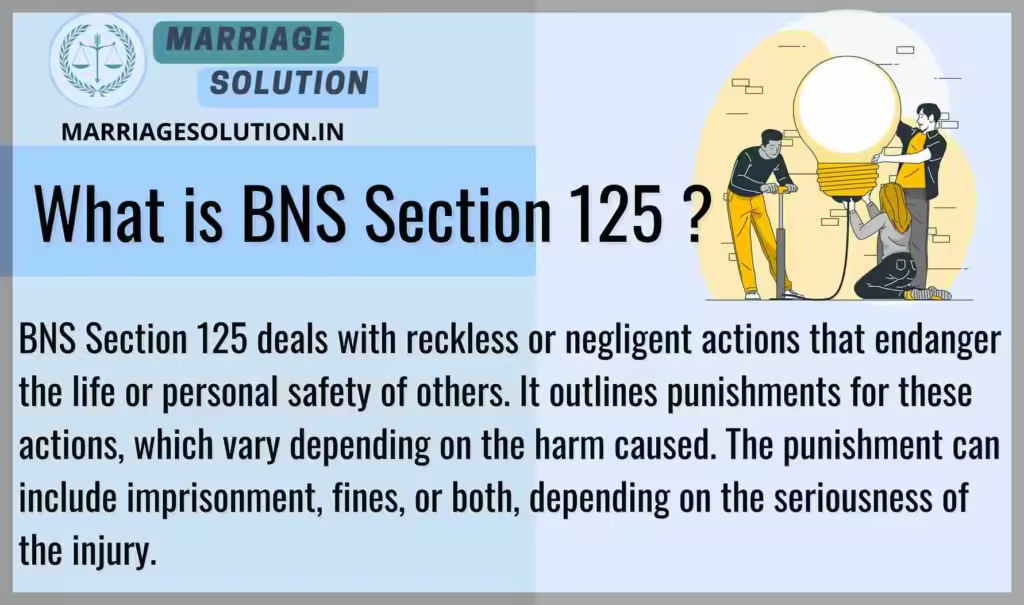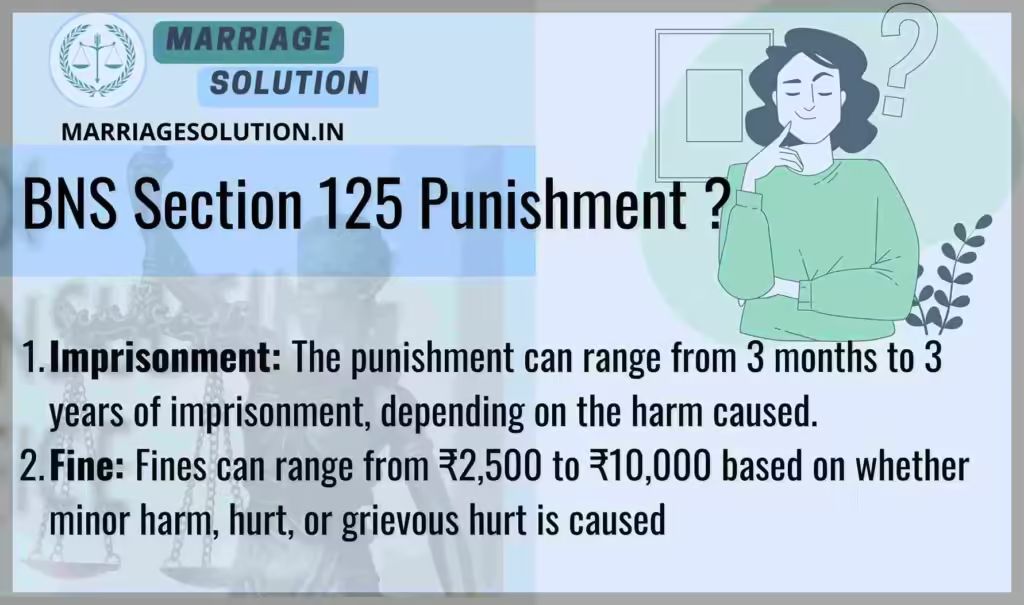Introduction of Section 125 BNS
BNS Section 125 focuses on rash and negligent acts that endanger human life or safety. This law ensures accountability when people act carelessly—such as reckless driving, unsafe construction practices, or mishandling dangerous substances. Even if no injury occurs, creating a life-threatening risk is punishable. If actual harm results—whether minor, ordinary hurt, or grievous hurt—the punishment becomes stricter. This provision is designed to protect society from accidents caused by negligence and emphasizes that careless actions can carry serious consequences.
The Bharatiya Nyaya Sanhita (BNS) Section 125 replaces the old Indian Penal Code (IPC) Section 338.
What is section 125 of BNS ?
BNS Section 125 deals with reckless or negligent actions that endanger the life or personal safety of others. It outlines punishments for these actions, which vary depending on the harm caused. The punishment can include imprisonment, fines, or both, depending on the seriousness of the injury.

BNS Act – BNS Section 125
(1) Whoever, by doing any rash or negligent act, endangers human life or the personal safety of others, shall be punished with imprisonment for a term which may extend to 3 months, or with fine up to ₹2,500, or with both.
(2) If such rash or negligent act causes hurt to any person, the offender shall be punished with imprisonment for a term which may extend to 6 months, or with fine up to ₹5,000, or with both.
(3) If such rash or negligent act causes grievous hurt to any person, the offender shall be punished with imprisonment for a term which may extend to 3 years, or with fine up to ₹10,000, or with both.
This section deals with reckless or careless acts that put people’s lives or safety at risk.
Even if no one is injured, the act itself is punishable. If injury or grievous injury results, the punishment becomes harsher.
Key Elements of Section 125
- Rash or Negligent Act → Includes reckless driving, unsafe handling of equipment, careless construction practices, or leaving hazardous materials unattended.
- Endangering Life/Safety → Even without actual harm, creating a dangerous situation for others is an offence.
- If Hurt is Caused → Minor injuries (like cuts, bruises, or pain) can lead to 6 months’ imprisonment or fine.
- If Grievous Hurt is Caused → Serious injuries (like fractures, permanent disability, or severe burns) can lead to up to 3 years in prison.
- Punishment Increases with Harm → The law scales punishment based on whether harm is minor, ordinary hurt, or grievous hurt.
- Cognizable & Bailable → Police can arrest without a warrant, but the accused has the right to apply for bail.
- Trial by Magistrate → These cases are handled by Magistrates, depending on the severity of the injury.
Example 1 (Minor Risk – No Major Injury):
A person drives rashly at high speed in a busy market, creating panic but causing no serious injury.
→ Punishment under Section 125(1): Up to 3 months’ imprisonment or ₹2,500 fine.
Example 2 (Hurt Caused):
A motorcyclist jumps a red light and collides with a pedestrian, causing bruises.
→ Punishment under Section 125(2): Up to 6 months’ imprisonment or ₹5,000 fine.
Example 3 (Grievous Hurt Caused):
At a construction site, a contractor negligently leaves tools unsecured. A heavy tool falls, breaking a passerby’s arm.
→ Punishment under Section 125(3): Up to 3 years’ imprisonment or ₹10,000 fine.
Why Section 125 is Important
- It ensures that negligence is not ignored, even when no one is harmed.
- It protects society by holding people accountable for reckless acts.
- It recognizes different levels of harm and applies proportionate punishment.
- It is a modernized replacement of IPC Sections 336–338, bringing all provisions under a single section for clarity.
- It acts as a deterrent against careless acts in public spaces, workplaces, and daily life.
Section 125 BNS Overview
BNS Section 125 deals with situations where someone’s reckless or careless actions put the lives or safety of other people in danger. If such actions cause harm, the person responsible can face punishment. The severity of the punishment depends on whether minor harm, injury, or serious injury (grievous hurt) was caused by their actions.
Section 125 BNS Overview :10 Key Points
- Reckless Actions: Acting without care and putting someone’s life or safety at risk is covered under this section.
- Endangering Life: Doing something careless that endangers other people’s lives can lead to punishment.
- Punishment for Minor Cases: If the act causes no major harm, the person can be jailed for up to 3 months or fined ₹2,500, or both.
- More Severe Punishment for Hurt: If someone is hurt, the punishment can increase to 6 months of jail or a fine of ₹5,000, or both.
- Grievous Hurt Increases Penalty: If a person is seriously hurt, the jail time can be as long as 3 years, with a fine of up to ₹10,000, or both.
- Types of Injury Matter: The severity of the punishment depends on the type of injury caused by the rash or negligent act.
- Cognizable Offence: This is a cognizable offence, meaning the police can arrest the person without a warrant.
- Bailable Offence: The person accused of this offence can get bail.
- Non-Compoundable: This means the case cannot be settled between the parties; it has to go through the legal process.
- Trial by Magistrate: The case will be tried in front of any Magistrate.
Two Examples of BNS Section 125
- Example 1: A driver is speeding in a crowded market, not paying attention to pedestrians. Due to his recklessness, someone gets hurt but not seriously. The driver is punished under BNS Section 125 with 6 months of imprisonment or a fine of ₹5,000.
- Example 2: A construction worker leaves tools unsecured on a high platform. Due to this negligence, a tool falls and seriously injures a passerby. The worker is held responsible under BNS Section 125 and faces up to 3 years in jail or a fine of ₹10,000.
BNS 125 Punishment
- Imprisonment: The punishment can range from 3 months to 3 years of imprisonment, depending on the harm caused.
- Fine: Fines can range from ₹2,500 to ₹10,000 based on whether minor harm, hurt, or grievous hurt is caused.

BNS 125 bailable or not ?
This offence is bailable, meaning the person can be released on bail while awaiting trial.
Compare BNS Section 125 vs IPC Section 336, 337 & 338
| Law Section | Offense | Punishment | Cognizable | Bailable | Trial By |
|---|---|---|---|---|---|
| BNS 125(1) | Rash or negligent act endangering human life or personal safety (no injury required). | Imprisonment up to 3 months, or fine up to ₹2,500, or both. | Yes | Yes | Any Magistrate |
| BNS 125(2) | Rash or negligent act causing hurt to any person. | Imprisonment up to 6 months, or fine up to ₹5,000, or both. | Yes | Yes | Any Magistrate |
| BNS 125(3) | Rash or negligent act causing grievous hurt to any person. | Imprisonment up to 3 years, or fine up to ₹10,000, or both. | Yes | Yes | Any Magistrate |
| IPC 336 | Act endangering human life or personal safety of others (rash/negligent act). | Imprisonment up to 3 months, or fine, or both. | Yes | Yes | Any Magistrate |
| IPC 337 | Rash or negligent act causing hurt to any person. | Imprisonment up to 6 months, or fine, or both. | Yes | Yes | Any Magistrate |
| IPC 338 | Causing grievous hurt by rash or negligent act. | Imprisonment up to 2 years, or fine, or both. | Yes | Yes | Any Magistrate |
BNS Section 125 FAQs
What is BNS Section 125?
It covers acts that endanger human life or personal safety due to negligence or recklessness.
What is the punishment for causing minor harm under Section 125?
The punishment is up to 3 months of imprisonment or a fine of ₹2,500, or both.
What happens if grievous hurt is caused?
The punishment can go up to 3 years of imprisonment or a fine of ₹10,000, or both.
Is this offence bailable?
Yes, this offence is bailable.
Who tries cases under BNS Section 125?
These cases are tried by any Magistrate.
Conclusion
Section 125 of the Bharatiya Nyaya Sanhita plays an important role in ensuring public safety and accountability for negligence. By categorizing punishments according to the severity of harm—ranging from minor acts to grievous injuries—it ensures fairness while maintaining deterrence. Unlike the older IPC, which split these provisions across multiple sections, BNS consolidates them into a single, clear law. In a time when reckless driving, unsafe workplaces, and careless actions often cause avoidable accidents, Section 125 stands as a strong reminder: negligence is not excused under the law, and safety of others must always come first.
Need Legal Support?
If you’re facing court proceedings, marriage-related issues, or any legal matter, our team at Marriage Solution – Lawyer Help is ready to guide you. Just complete our easy online enquiry form, and we’ll connect you with the right legal assistance tailored to your needs.
Finished with BNS 125 ? Continue exploring the next provisions of the Bharatiya Nyaya Sanhita (BNS), 2023. Each section includes explanations, examples, and plain-language breakdowns for easy understanding.
- BNS 126 : Wrongful restraint .
- https://marriagesolution.in/bns_section/bns-126/
- 127 BNS : Wrongful confinement .
- https://marriagesolution.in/bns_section/127-bns/
- BNS Section 128 : Force .
- https://marriagesolution.in/bns_section/bns-section-128/
- BNS Section 129 : Criminal force .
- https://marriagesolution.in/bns_section/bns-section-129/
- BNS Section 130 : Assault .
- https://marriagesolution.in/bns_section/bns-section-130/
Full IPC Section List: https://marriagesolution.in/ipc-section-list
All Indian Law & Blogs: https://marriagesolution.in/indian-law/
Full BNSS Section List: https://marriagesolution.in/bnss_section-list
